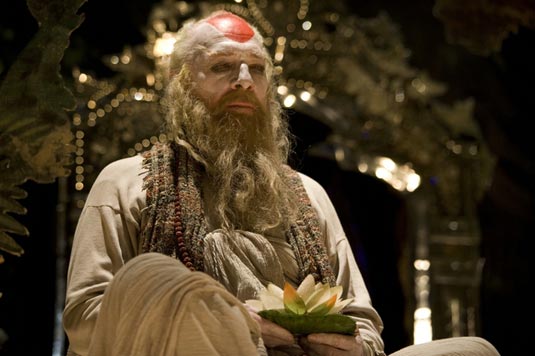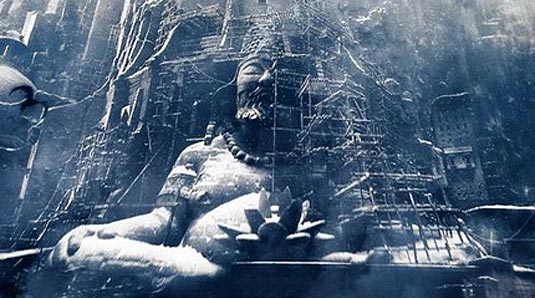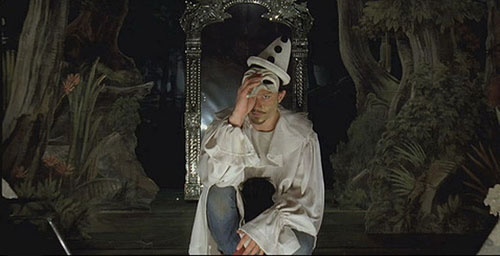 It’s nice to finally see a Terry Gilliam film on the big screen again. It’s been a long time since the back-to-back box office debacles of BRAZIL (1985) and THE ADVENTURES OF BARON MUNCHAUSEN (1988) sent him scurrying to prove that he could turn a profit by working more as a hired gun than an auteur, directing other people’s screenplays or adapting other people’s books instead creating his own original scenarios. The results have been sometimes satisfying (THE FISHER KING and 12 MONKEYS were not only entertaining; they also connected thematically with his own work), sometimes frustrating (FEAR AND LOATHING IN LAS VEGAS caught the ups and downs of a drug-fueled perspective but didn’t necessarily make us care about that perspective), and sometimes disappointing (THE BROTHERS GRIMM feels like an attempt to cram Gilliam’s usual concerns into the format of a commercial Hollywood film, with results that are not only dire but also dull). Good, bad, or indifferent, none of these titles quite qualifies as a genuine “Terry Gilliam Film” despite the possessory credit he managed to maintain on screen. (There was one near-miss: the aborted THE MAN WHO KILLED DON QUIXOTE, with a screenplay co-written by Gilliam, would have been a return to form, but it was felled by numerous disasters, as depicted in the documentary LOST IN LA MANCHA.)
It’s nice to finally see a Terry Gilliam film on the big screen again. It’s been a long time since the back-to-back box office debacles of BRAZIL (1985) and THE ADVENTURES OF BARON MUNCHAUSEN (1988) sent him scurrying to prove that he could turn a profit by working more as a hired gun than an auteur, directing other people’s screenplays or adapting other people’s books instead creating his own original scenarios. The results have been sometimes satisfying (THE FISHER KING and 12 MONKEYS were not only entertaining; they also connected thematically with his own work), sometimes frustrating (FEAR AND LOATHING IN LAS VEGAS caught the ups and downs of a drug-fueled perspective but didn’t necessarily make us care about that perspective), and sometimes disappointing (THE BROTHERS GRIMM feels like an attempt to cram Gilliam’s usual concerns into the format of a commercial Hollywood film, with results that are not only dire but also dull). Good, bad, or indifferent, none of these titles quite qualifies as a genuine “Terry Gilliam Film” despite the possessory credit he managed to maintain on screen. (There was one near-miss: the aborted THE MAN WHO KILLED DON QUIXOTE, with a screenplay co-written by Gilliam, would have been a return to form, but it was felled by numerous disasters, as depicted in the documentary LOST IN LA MANCHA.)
After this long history of frustration and disappointments, the release of THE IMAGINARIUM OF DOCTOR PARNASSUS (which opens today in limited Oscar-qualifying engagements before widening next year) is a moment worth celebrating. This is an authentic Terry Gilliam film, written with long-time collaborator Charles McKeown (who co-scripted BRAZIL and MUNCHAUSEN), which traffics in themes that characterize Gilliam’s best work: It’s about the importance of imagination over pragmatism, about the capacity of fantasy to enrich souls deadened by the weight of too much reality. Or put another way, this is a film that celebrates the all important “Sense of Wonder” that is at the heart of the best cinefantastique.
It would be supremely satisfying, therefore, to announce that THE IMAGINARIUM OF DOCTOR PARNASSUS is a triumphant return to form for Gilliam; unfortunately, the film represents a return of both the strengths and weaknesses inherent in his work. For all his extolling of the virtues of imagination and wonder, Gilliam often finds it difficult to capture that wonder on screen; the result is a little bit like listening to someone deliver a lecture on the benefits of humor, without being able to actually tell a funny joke.

Gilliam dramatizes his theme in the opening sequence: In modern day England, outside a night-club frequented by drunken dullards, an ancient traveling sideshow – the titular “Imaginarium of Doctor Parnassus” – roles out its wares for an unappreciative public. We immediately know that we are supposed identify with Parnassus (Christopher Plummer) and his traveling troup of performers, including the handsome young Anton (Andrew Garfield), the diminutive Percy (Verne Troyer, Mini-Me in the AUSTIN POWERS movies), and Parnassus’ daughter Valentina (Lily Cole); however, their performance is so dull that one easily understands the derisive reaction it receives. The show consists mostly of Parnassus sitting in an immobile trance, and things only get interesting when one obnoxious club-goer storms the stage and disappears through a mirror that takes him into an alternate reality. Confusion then ensues when Parnassus admonishes his daughter that this is never supposed to happen. (What? Parnassus expects his audiene to take his word for the wonders on the other side of the mirror?)
After this awkward opening, we go into a long stretch filling in the back story. Doctor Parnassus, we learn, is immortal, or at least very long-lived; he has spent decades if not centuries of millenia matching wits in an on-going contest with the devilish Mr. Nick (an excellent Tom Waits). The latest challenge involves who can be the first to save or damn a certain number of souls, with Valentina as the prize. Complicating matters is the fact that the young Valentina, who is about to become of age, yearns to leave behind the wonders of her father’s Imaginarium, in favor of a simple domestic life – one which the smitten Anton would love to bestow upon her, if only she would return his ardent love.
The set-up is rich with possibilities, presenting us with interesting variations on characters seen in previous Gilliam films. The aging Doctor Parnassus, with his tall tales of fantastic adventures, is another version of Baron Munchausen; as embodied by Plummer, he also bears a strong resemblance to the romantic idealist Don Quixote – a semblance further underlined by the presence of Troyer in what is essentially the “Sancho Panza” role – the voice of ironic pragmatism that calls Parnassus back to practical matters that he might overlook from having his head too far in the clouds. Likewise, Parnassus’s daughter Valentina is an older, post-adolescant version of the young girl from MUNCHAUSEN – the latest incarnation of a recurring character in Gilliam’s work, the next generation charged with taking up the baton from the old teller of wild tales.

Unfortunately, the story construction is delivered in the form of leaden exposition lacking any spark of creative life (even flashbacks of the first encounter between Parnassus and Mr. Nick do little to galvanize the tedious first act). The love story between Anton and Valentina is written in generic terms, and the performers, though appealing, are unequal to the tast of making us feel the desire, yearning, and passion that the script has not supplied. Consequently, THE IMAGINARIUM OF DOCTOR PARNASSUS begins to feel abstract and distant, a film about wonder without any actual wonder in it.
Fortunately for all concerned, the troop discovers a body hanging by his neck from a bridge. The not-quite-dead man turns out to be Tony (Heath Ledger), who has no memory of how he came to be in that near-fatal position – although the presence of a small metal tube in his throat, which prevented his wind pipe from being closed by the noose, suggests he escaped a murder attempt. By virtue of the mystery surrounding him, Tony is more interesting than the other characters; he has an ambiguity the others lack. He is also performed by an actor with the skill to take over the screen and breathe some life into the lethargic proceedings. Once Ledger appears, THE IMAGINARIUM OF DOCTOR PARNASSUS almost turns into another movie: What had seemed dry and academic up to this point becomes fun, entertaining, and even, at times, wonderful.
Tony immediately sees what has been obvious to the audience from the opening scene: the Imaginarium of Doctor Parnassus is badly in need of an update for the 21st century. He radically revamps the presentation, easily luring in new customers who are enthralled and beguiled by their brief visits to the wonderland residing behind the magical irror. This leads to several sequences in which Gilliam shows off his patented visual flair for fantasy; although in this case the old hand-made style makes way for modern computer-generated effects, much of the old charm retains intact.

These are also notable because they involve the three other actors as Tony: Johnny Depp, Jude Law, and Colin Farrell. Although THE IMAGINARIUM OF DOCTOR PARNASSUS should right be viewed as an auteur piece that resides comfortably within the context of of Terry Gilliam’s previous work, it will inevitable be regarded through the prism of the unfortunate circumstance of its creation: Heath Ledger died after completing all of the “reality” scenes, forcing Gilliam to recast Tony. Although certainly unusual, this is not a unique strategy; Luis Bunuel did something similar in THAT OBSCURE OBJECT OF DESIRE (1977), with similar results: namely, making the character more abstract, more of a mystery, someone who presents more than one face to the world, leaving you to wonder which, if any, represents the reality of the identity within.
The result works perfectly on screen. If you happen to be one of the few ticket-buyers unaware of the film’s tragic history, the substition of alternate faces seems integral to the story (Tony enters the Imaginarium with different characters; each new appearance of his conforms to what these other characters want to see). For the majority of viewers, who do know the story behind the making of IMAGINARIUM OF DOCTOR PARNASUS, the sight of the late Ledger’s friends – Depp, Law, and Farrell – filling in for him is not only magical but sadly moving, as they channel some essence of inner character, suggesting an underlying continuity hidden behind their different faces. It is really not fair to judge a film’s achievements based on such a matter of necessity, but these moments really will bring a pang to your heart. In the past, Gilliam has spoken of his need to confront challenges in order to achieve his best results; faced with a seemingly insurmountable one, he managed to find a solution that serves both the film and the memory of its late star, acting as a fitting tribute (although the title card “A Film by Heath Ledger and his Friends” borders on exploiting the actor’s death).
In any case, thanks to Tony’s showmanship, Doctor Parnassus is soon reclaiming the souls of enough customers to edge ahead in his contest with Mr Nick – until complications set in. There are hints that Tony may have been involved in raising money for the poor, but a disreputable air hangs around him – the air of a con man. Valentina sees only the charm; Anton is of course suspicious. The love triangle leads to trouble, and in a rather unusual development, Valentina allows herself to be seduced by the mystery man. Her transformation from virginal innocence to post-coital bliss is one of the more striking images in the film, but it exists in a vacuum virtually without consequences (after its plot function is served, it is simply forgotten, with no effect on the character’s ultimate fate).
Eventually, the truth about Tony is revealed; Valentina rebels against her father; and Doctor Parnassus takes action to rescue Valentina from Tony and/or Mr. Nick, leading to the film’s other unusual element (for Gilliam at least): an ending in which conventional, boring, ordinary life is upheld as the ideal of happiness. The thematics are vaguely askew, perhaps just simply vague. The tryst between Tony and Valentine ignites the sparks lacking in the love story between Anton and Valentina, suggesting some schism between love and passion; it’s one step removed from the suggetion that female sexual satisfaction occurs only in a context of tawdry duplicity. Apparently having learned her lesson, Valentina retreats into a domestic life reminiscent of a sexless ’50s television show.
Regardless of whether the thematic threads can be sorted out in a satisfying way, the latter portions of THE IMAGINARIUM OF DOCTOR PARNASSUS retain their appeal, rewarding the audience for sitting through the slow set-up. Plummer brings dignity and an air of sadness to the aging Parnassus, and Troyer’s Percy is the perfect foil for the old wizard. Waits is excellent as the unctuous Mr. Nick, sly and insinuating, always insisting that he enjoys the contest with Parnassus for the sport, not for a chance to win his soul. But above it all, the film is a triumph for Ledger. Although the role is no match for his insanely effective turn as the Joker in THE DARK KNIGHT, his presence illustrates how a star can illuminate material that is otherwise not as bright as it should be. His presence lights up the film and goes a long way toward eclipsing its imperfections. Thanks to him, Gilliam fans in a forgiving frame of mind can leave the theatre feeling that THE IMAGINARIUM OF DOCTOR PARNASSUS was almost everything it should have been.
THE IMAGINARIUM OF DOCTOR PARNASSUS (2009). Directed by Terry Gilliam. Written by Terry Gilliam and Charles McKeown. Cast: Christopher Plummer, Andrew Garfield, Lily Cole, Verne Troyer, Tom Waits, Heath Ledger, Johnny Depp, Jude Law, Colin Farrell, Peter Stormare.
[serialposts]